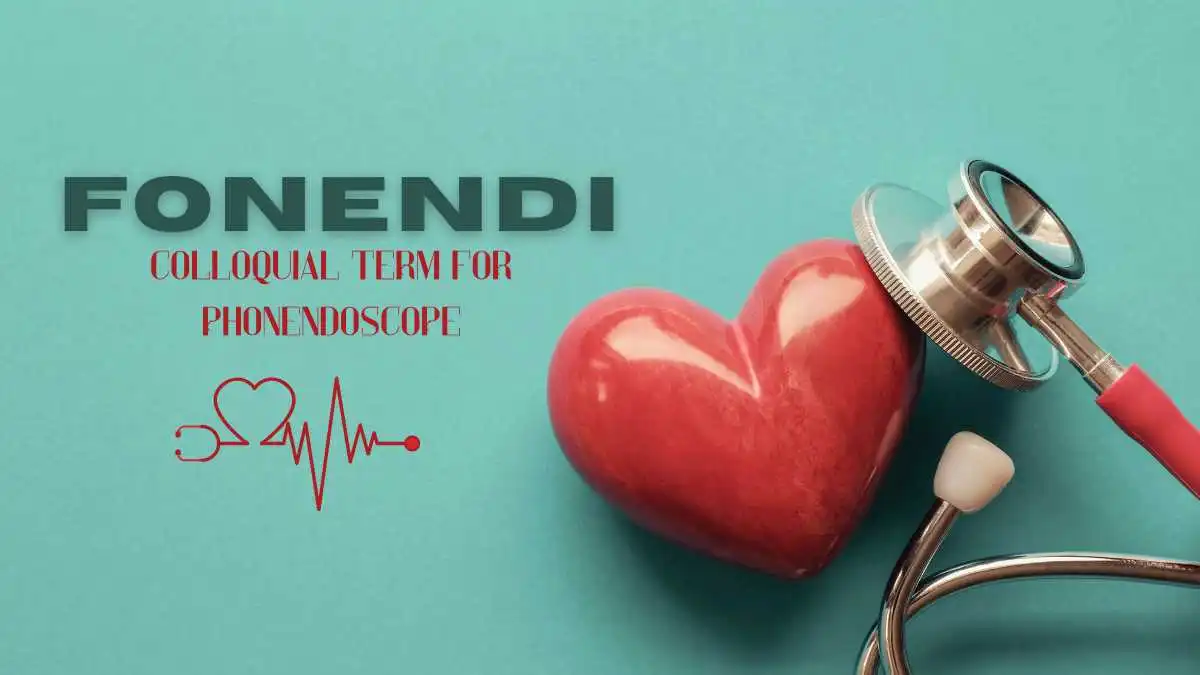HEALTH AND FITNESS
Fonendi – Colloquial Term for Phonendoscope

Fonendi is a colloquial term for the phonendoscope, a medical device designed to amplify internal body sounds. This instrument is a variant of the more commonly known stethoscope. Healthcare professionals use it to listen to physiological activities within the body, such as the rhythm of a heartbeat, the movement of air through the lungs, and the motility of the digestive system. Although “fonendi” is not used in formal clinical documentation, it is a shorthand embraced by medical professionals for ease of communication, especially in fast-paced environments.
Etymology and Linguistic Roots
The word phonendoscope has its roots in the Greek language:
- Phono (φωνή) means sound.
- Endo (ἔνδον) means within.
- Scope (σκοπέω) means to look or to examine.
Combining these elements, the term phonendoscope means “an instrument to examine internal sounds.” The informal derivative, fonendi, is a truncated and more accessible version, commonly used in verbal exchanges in hospitals and classrooms alike
The Evolution of the Phonendoscope
The phonendoscope, a late 19th-century modification of the stethoscope, was invented by the namesake. Even though the binaural stethoscope was invented in 1816, a series of adjustments were made to come up with the physical changes of this instrument. There was also a significant improvement in the phonendoscope; the sound amplification in the phonendoscope was also improved, and a diaphragm was added to it to make it sensitive in the diagnosis.
In modern fonendis, both the diaphragm and the bell portions are included:
- High-frequency sounds such as breath and normal heartbeats are detected using the diaphragm.
- The bell picks up the low-frequency sounds like heart murmurs or bowel movements.
How Fonendi Works
A fonendi is simply a theory that goes on with basic acoustic principles. In such cases, when the diaphragm or bell is applied against the body skin of a patient, the sound produced throughout the hollow tubing will be transmitted to the ears of the listener. Through this acoustic relay, medical personnel can be enabled to identify abnormalities like irregular heart rate or breathing (wheezing), and digestive problems.
Key components include:
- Chest piece: Usually double-sided, containing both the diaphragm and the bell.
- Tubing: Flexible and acoustically efficient, connecting the chest piece to the earpieces.
- Earpieces: Soft, snug-fitting tips that deliver sound directly to the practitioner’s ears.
Clinical Applications
- Cardiovascular health: Inspect the presence of heart murmurs, arrhythmias, and valve defects.
- Check the condition of the lungs: check crackles, rales, rhonchi, or lack of breath sounds.
- Observation of the gut: Keep monitor of gastrointestinal activity, including signs of obstruction or ileus.
- Blood pressure measurement: When combined with a sphygmomanometer, it is used to auscultate Korotkoff sounds.

Types of Fonendi
| Type | Main Use | Key Features | Target Audience | Sound Quality |
| Acoustic Fonendi | General auscultation in routine exams | Relies on sound wave transmission via hollow tubes | Doctors, nurses, medical students | Good for most clinical purposes |
| Electronic Fonendi | Enhanced diagnostics, telemedicine | Amplifies sound electronically; may include noise cancellation | Cardiologists, specialists, remote clinics | Excellent—high amplification and clarity |
| Pediatric Fonendi | Examining infants and children | Smaller diaphragm and bell for better contact on smaller bodies | Pediatricians, neonatologists | Optimized for higher-pitched sounds |
| Cardiology Fonendi | Detecting subtle heart abnormalities | Tuned diaphragm for better low-frequency detection | Cardiologists, internal medicine doctors | Superior for low-frequency heart sounds |
Fonendi in Medical Culture
Despite being informal, fonendi has been lodged in the medicine culture. Professors in teaching hospitals mention it in a casual way in teaching students. Nurses could request their colleagues to pass the fonendi and reporters may swoop in during the checkup. This common form portrays how the instrument is everywhere and how professionals grow to be familiar with it.
The pervasiveness of the term also indicates the way language is adjusted to clinical use. The same way BP signifies blood pressure and EKG the electrocardiogram, it is a comfortable, short addition to the language.
Training and Proper Use
It is simply designed, but auscultation needs training and practice. In the process of medical education:
- Distinguish between natural and abnormal sounds.
- Change the pressure and placement chest piece.
- Be clean to avoid cross-infection among patients.
It can be used by a skilled clinician to acquire substantial information within seconds, which speaks of the importance of experience when learning how to use such a tool.
Maintenance and Care
Maintenance may make it last longer and accurately. Among the most important practices are:
- Cleaning diaphragm and earpieces with alcohol-based solutions regularly.
- Store the tube in a cool, dry place to prevent tube hardening.
- A checkup of the cracks or loose pieces, or distortion occasionally.
As it is the key to the interaction with the patient, a clean and working fonendi also supports the professional conduct of hygiene and care.
The Symbolism of Fonendi in Medicine
In addition to clinical use, the fonendi has taken an image of the healthcare profession. Like the white coat or surgical mask, a fonendi that is wrapped around the neck is a representation of preparedness, power, and empathy. It means that the practitioner is ready to listen not only with his/her ears, but with sensitivity and precision to the needs of the patient.
It appears everywhere, in hospital corridors, medical drama, and student ceremonies, and underlines its iconic image in the world of medicine.
Conclusion
Although the word fonendi is informal, its meaning is not so at all. It summarizes a very important medical instrument that is still ongoing development with healthcare technology. Based on the art of auscultation, put in a bit of the culture of medicine and poured on top of the potion, the functions of familiarity, you have the fonendi. Either in its traditional analogue variant or improved with digital technology, it is an irreplaceable part of the diagnostic toolbox of medical workers, being guaranteed that the silence spoken by the human body is finally not ignored, misunderstood, and followed by some action.
-

 BIOGRAPHY7 months ago
BIOGRAPHY7 months agoBehind the Scenes with Sandra Orlow: An Exclusive Interview
-

 HOME1 year ago
HOME1 year agoDiscovering Insights: A Deep Dive into the //vital-mag.net blog
-

 HOME1 year ago
HOME1 year agoSifangds in Action: Real-Life Applications and Success Stories
-

 BIOGRAPHY1 year ago
BIOGRAPHY1 year agoThe Woman Behind the Comedian: Meet Andrew Santino Wife




























